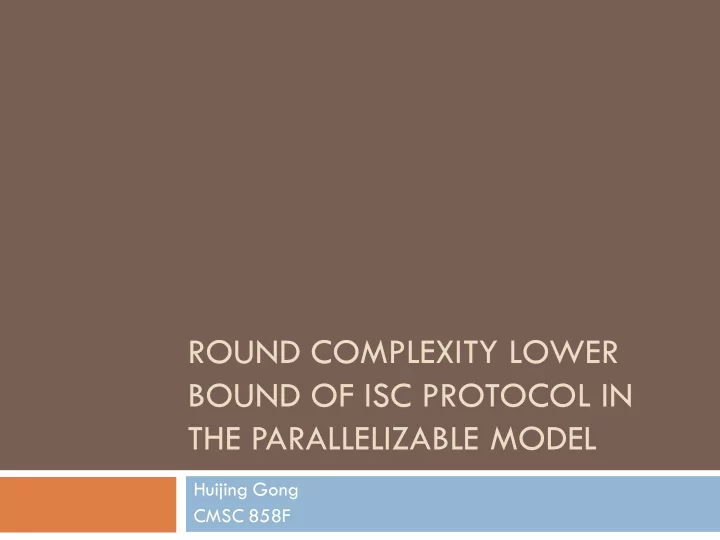

ROUND COMPLEXITY LOWER BOUND OF ISC PROTOCOL IN THE PARALLELIZABLE MODEL Huijing Gong CMSC 858F
Overview Background Byzantine Generals Problem Network Model w/o Pre-existing Setup ISC Protocol in Parallelizable Model ISC, Parallelizable Model Intuition of Protocol Round Complexity Lower Bound Theorem Proof
Background Byzantine Generals Problem Commanding general and generals camped outside an enemy city Commanding general sends the order to all The generals exchange messages to agree on a battle plan: withdraw or attack Traitor(s): confuse others
Background Byzantine Generals Problem Commander Commander Attack! Withdraw! Attack! Attack! General A General B General A General B Commander said “Withdraw!” Commander said “Attack!” Traitor(s): confuse others
Background Byzantine Generals Problem Commander Commander Attack! Withdraw! Attack! Attack! General A General B General A General B Commander said “Attack!” Commander said “Withdraw!” Goal of Byzantine Agreement Protocols: Generals reach agreement on whether attack or withdraw Not obey Commander’s order if Commander is a traitor
Background Network Model w/o Pre-Existing Setup N Parties: cannot be authenticated by pre-existing means E.g. Public-Key Infrastructure (PKI) Difference: No idea where a receive message sent from No idea if two message received from different rounds are sent from one party But, a message sent by an honest party in some run received by all other parties at the end of that run
Background Network Model w/o Pre-Existing Setup Adversary: Corrupt parties to behave arbitrarily Inject message into the network ( > n -1) Change messages they relay Send message to subset of the honest parties (< n - 1)
ISC Protocol in Parallelizable Model Protocol (by J. Katz, A. Miller, and E. Shi [2014]): N Parties: cannot be authenticated by pre-existing means Goal: Establish a PKI No bound on the number of corruption Adversary cannot drop or modify honest parties’ message Time-Lock Puzzle (Proof-of-Parallelizable Work Model) Take role of trusted setup assumption Each honest party has equal computational power Adversary(f parties) runs sequentially faster by factor f f correct parties cannot solve any faster taking as whole.
ISC Protocol in Parallelizable Model Interactive Set Consistency (ISC): Each party has an input and output a (multi)set of size n, s.t. All the honest parties agree(output) on the same (multi)set S S contains all the honest parties’ inputs Can be used to establish PKI among parties, PKI later can provide authenticated communication
ISC Protocol in Parallelizable Model 𝑞𝑏𝑠𝑞𝑣𝑨 Oracle ℱ Modeling the Time-Lock Puzzle Each party can produce a puzzle solution independently in each round An adversary who corrupts f processes can solve f puzzles per round in total Scheme Solve a cryptographic puzzle upon request Check solutions upon request Polynomial Time
ISC Protocol in Parallelizable Model 𝑞𝑏𝑠𝑞𝑣𝑨 Oracle ℱ Solve: 𝑞𝑏𝑠𝑞𝑣𝑨 oracle maintains a table T. ℱ Each party 𝑄 𝑗 sends (solve, 𝑦 𝑗 ) to ℱ 𝑞𝑏𝑠𝑞𝑣𝑨 oracle: For I = 1, …, n, ℱ 𝑞𝑏𝑠𝑞𝑣𝑨 first check if ( 𝑦 𝑗 , ℎ 𝑗 ) has been stored in T. Yes: return ℎ 𝑗 to 𝑄 𝑗 ; Otherwise, generate ℎ 𝑗 ∈ { 0, 1} 𝜇 , return ℎ 𝑗 to 𝑄 𝑗 and store ( 𝑦 𝑗 , ℎ 𝑗 ) in T.
ISC Protocol in Parallelizable Model 𝑞𝑏𝑠𝑞𝑣𝑨 Oracle ℱ Solve: Each honest party is allowed to call ℱ 𝑞𝑏𝑠𝑞𝑣𝑨 only once per round Each round of honest party: All the solve request must be sent before any honest party receives its solution. Each round of corrupted parties: they can call ℱ 𝑞𝑏𝑠𝑞𝑣𝑨 one after another in sequence up to f times.
ISC Protocol in Parallelizable Model 𝑞𝑏𝑠𝑞𝑣𝑨 Oracle ℱ Check: 1 , ℎ 𝑗 1 ), ( 𝑦 𝑗 2 , ℎ 𝑗 2 ), …) to Each party 𝑄 𝑗 sends (check, ( 𝑦 𝑗 𝑞𝑏𝑠𝑞𝑣𝑨 oracle: ℱ 1 , 𝑐 𝑗 2 ,…): 𝑞𝑏𝑠𝑞𝑣𝑨 oracle returns ( 𝑐 𝑗 ℱ j = 1 if (𝑦 𝑗 2 , ℎ 𝑗 2 ) ∈ 𝑈 𝑐 𝑗 j = 0 , otherwise. 𝑐 𝑗
ISC Protocol in Parallelizable-Work Model Orders in rounds (honest parties) Each party sends (at most) one solve-request to 𝑞𝑏𝑠𝑞𝑣𝑨 and receive the solution ℱ Each party computes a message to send Message are delivered to each party Each party sends a list of puzzle solution to ℱ 𝑞𝑏𝑠𝑞𝑣𝑨 for verification
ISC Protocol in Parallelizable-Work Model Intuition of the Protocol: Mining Phase: Each correct party generate a chain of 𝑃(𝑔 2 ) puzzle solutions: E.g. Solve( 𝑞𝑙 𝑗 , Solve( 𝑞𝑙 𝑗 , Solve(…Solve( 𝑞𝑙 𝑗 ,𝜚) …))) Each correct party can create a valid puzzle chain for its own key, Corrupt party only can create at most f puzzle chains before the protocol terminate
ISC Protocol in Parallelizable-Work Model Intuition of the Protocol: Communication Phase: Each party publishes their chains and propagate the puzzle chain they received from others In each round r: Each party accepts a value if it has received a collection of r signatures on that value, the process then add its own signature to the collection and relay it to the other processes. Signatures without associated puzzle chains are ignored A correct party consider a public key “valid” if it comes along with a puzzle chain containing the public key long enough
Reference Aguilera, Marcos Kawazoe, and Sam Toueg. "A simple bivalency proof that t-resilient consensus requires t+ 1 rounds." Information Processing Letters 71.3 (1999): 155-158. Dolev, Danny, and H. Raymond Strong. "Authenticated algorithms for Byzantine agreement." SIAM Journal on Computing 12.4 (1983): 656-666. Lamport, Leslie, Robert Shostak, and Marshall Pease. "The Byzantine generals problem." ACM Transactions on Programming Languages and Systems (TOPLAS) 4.3 (1982): 382-401. Katz, Jonathan, Andrew Miller and Elaine Shi. "Pseudonymous Secure Computation from Time-Lock Puzzles." Cryptology ePrint Archive (2014):857.
Recommend
More recommend